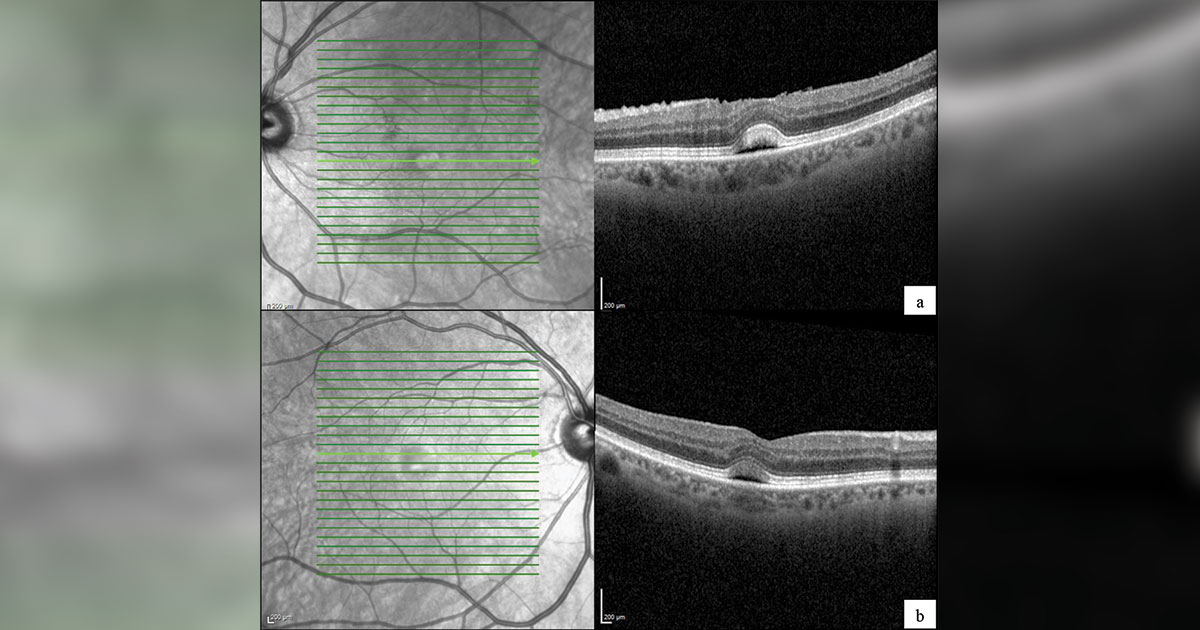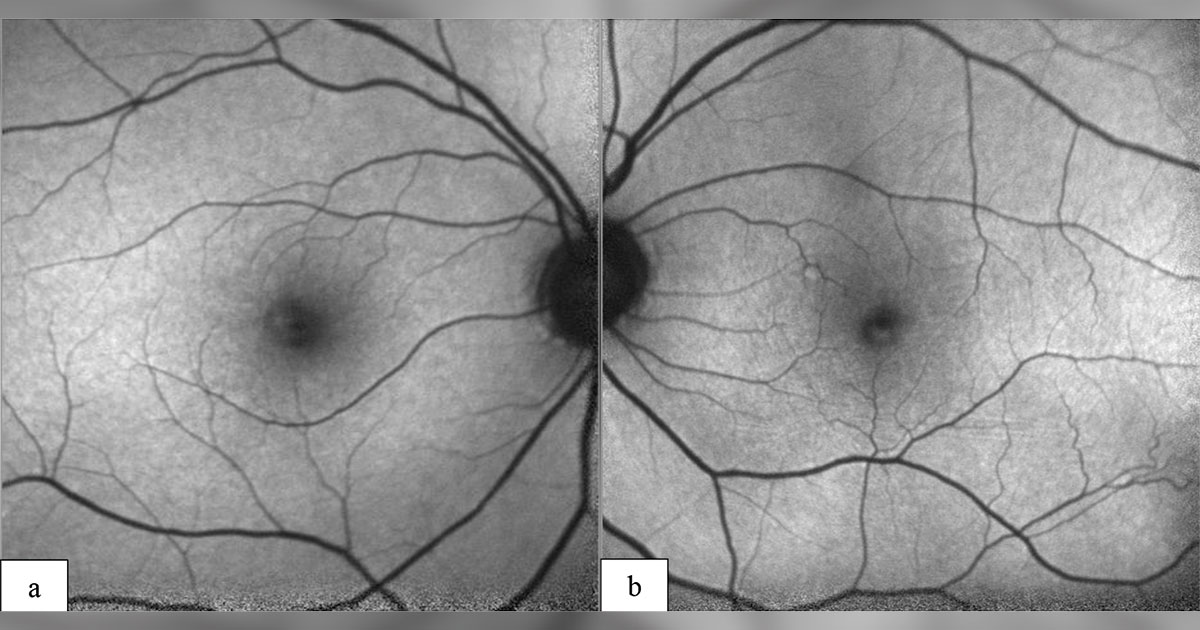Man referred for medication monitoring without ocular symptoms
A 75-year-old man was referred to the retina service by his comprehensive ophthalmologist for high-risk medication monitoring. The patient denied acute ocular symptoms such as vision loss, flashes, floaters or eye pain.


His ocular history included bilateral dry eyes, cataracts and astigmatism. His medical history was notable for bladder cancer, for which he was on treatment, and hyperlipidemia. He had a history of ankle surgery and had his bladder, prostate and spleen removed, but he had never had ocular surgery. He was allergic to penicillin. He had no history of smoking, alcohol use or drug use. Family history was noncontributory. On review of systems, he endorsed extreme fatigue, mouth sores, hair loss, changes in his fingernails and loss of appetite.

Source: Heba Mahjoub, MD, and Jeffrey Marx, MD


Examination
On initial exam, best corrected visual acuity was 20/30 in the right eye and 20/25-3 in the left eye. IOP was 22 mm Hg in the right eye and 14 mm Hg in the left eye. Pupils were equal, round and reactive to light without an afferent pupillary defect. Confrontation visual fields and extraocular motility were full, and the patient was orthophoric in both eyes. His anterior segment exam was within normal limits, apart from 1 to 2+ nuclear sclerotic cataract in both eyes. The vitreous was clear and quiet. Posterior exam revealed a healthy optic disc and vessels, with prominent central fluid within the macula in both eyes (Figure 1).
OCT of the macula showed small subfoveal retinal pigment epithelial (RPE) detachments in both eyes with marked thickening of the RPE layer (Figure 2). Fundus autofluorescence was also performed, revealing hypoautofluorescent and hyperautofluorescent patches in the central macula of both eyes (Figure 3).
What is your diagnosis?
See answer below
Bilateral subretinal fluid
The differential diagnoses for this patient’s presentation include central serous chorioretinopathy, medication toxicity, inflammatory etiologies such as posterior scleritis or Vogt- Koyanagi-Harada disease, infectious etiologies such as syphilis, tuberculosis or sarcoidosis, and malignancy such as lymphoma or leukemia. In this case, the differential diagnosis was further narrowed by a history of metastatic bladder cancer, for which he was being treated with the chemotherapy agent erdafitinib.
Discussion
Cancer care has advanced in the past few decades, with many treatments now targeting unique tumor mutations that spare healthy tissue. These treatments may cause fewer side effects and toxicities overall. However, while they may significantly improve patients’ quality of life, in some cases they can have an unintended impact on patients’ vision.
In January 2024, the FDA approved erdafitinib, a pan-fibroblast growth factor receptor inhibitor (FGFRi), for a subset of adults with locally advanced or metastatic urothelial carcinoma. This subset of patients had cancer that had already progressed on or after at least one systemic therapy, and they also had a susceptible FGFR3 mutation. Compared with chemotherapy (docetaxel or vinflunine), erdafitinib therapy was found to significantly prolong overall survival in patients with metastatic urothelial cancer and FGFR3 mutations, making it an ideal treatment option. Given its benefit and anticipated increased frequency in usage, ophthalmologists must be aware of possible ocular side effects these patients may face. FGFR has previously been connected to the development and survivability of retinal cells through cell proliferation, migration and differentiation. Several case reports have shown erdafitinib to cause subretinal detachments and buildup of hyperreflective subretinal material. Becker and colleagues proposed that inhibiting FGFR using erdafitinib can lead to apoptosis of proteins with possible damage and degeneration of RPE cells, resulting in retinal fluid buildup similar to the pathogenesis of central serous chorioretinopathy. Other ocular side effects can also arise with erdafitinib use. In a large cohort of patients taking erdafitinib, 42.2% experienced dry eye or conjunctivitis. Other FGFRi therapies currently being studied, such as ASP-5878 and FPA-144, have also been implicated in significant corneal epithelial changes, which can present months after initiation of the medications.
The most frequently described symptoms from erdafitinib toxicity include blurry vision and metamorphopsia. Some patients may even present asymptomatically, as our patient did. OCT of the macula is crucial for diagnosis, as it typically shows multifocal pigment epithelial detachments with secondary subretinal fluid. Treatment of this toxicity includes dose reduction or cessation of the therapy, in addition to a lubrication regimen to counter any corneal changes. Previous case studies have shown reversal of the retinopathy within days or up to 2 to 4 weeks after discontinuation. Erdafitinib does not need to be discontinued if the patient is completely asymptomatic with no visual changes; therefore, it is important for the ophthalmology and oncology teams to have careful discussions with the patient regarding risks and benefits, along with need for close monitoring during treatment. To date, there is no consensus among ophthalmologists regarding FGFR retinopathy screening. Mahipal and colleagues recommend monthly exams for the first 4 months after starting FGFRi with slit lamp evaluation, OCT and dilated fundus exam, followed by visits once every 3 months if no toxicities are detected. As these novel treatments are used in increasing frequency, further studies will be required to clarify guidelines to help minimize undue ocular disease.
Clinical course
When the patient was first referred to our clinic, he had no noticeable changes in his visual acuity. His initial chemotherapy regimen had consisted of enfortumab vedotin and pembrolizumab, but he was ultimately transitioned to erdafitinib and had been on a 6 mg to 8 mg dose for 3 months, at which point he developed bilateral subretinal fluid and was advised to suspend his immunotherapy treatment until further retina evaluation.

At the patient’s follow-up 1 month later, the fluid had resolved. Therefore, erdafitinib was resumed at a lower dose of 5 mg daily. Three weeks after starting this lower dose, he developed recurrence of subretinal fluid, prompting his oncologist to again discontinue erdafitinib. At a 1-week retina follow-up, he had a very small amount of remaining subretinal fluid (Figure 4). Given the fluctuation, a discussion between oncology and ophthalmology weighed the risk of stopping treatment with the benefit of an improved retina exam. The decision was made to allow continued treatment with erdafitinib even with recurrence of subretinal fluid. The patient will continue to be followed every few weeks to monitor for changes in visual symptoms.
- References:
- Becker B, et al. J Vitreoretin Dis. 2022;doi:10.1177/24741264221092908.
- FDA approves erdafitinib for locally advanced or metastatic urothelial carcinoma. https://www.fda.gov/drugs/resources-information-approved-drugs/fda-approves-erdafitinib-locally-advanced-or-metastatic-urothelial-carcinoma. Published Jan. 19, 2024. Accessed May 21, 2024.
- Guillonneau X, et al. Mol Biol Cell. 1998;doi:10.1091/mbc.9.10.2785.
- Loriot Y, et al. N Engl J Med. 2023;doi:10.1056/NEJMoa2308849.
- Mahipal A, et al. Crit Rev Oncol Hematol. 2020;doi:10.1016/j.critrevonc.2020.103091.
- Moussa K, et al. JAMA Ophthalmol. 2019;doi:10.1001/jamaophthalmol.2018.2759.
- Parikh D, et al. JAMA Ophthalmol. 2020;doi:10.1001/jamaophthalmol.2020.2778.
- Patel SN, et al. Case Rep Ophthalmol. 2022;doi:10.1159/000519275.
- Prensky C, et al. J Vitreoretin Dis. 2017;doi:10.1177/2474126417751724.
- Shin E, et al. BMC Ophthalmol. 2020;doi:10.1186/s12886-019-1285-9.
- For more information:
- Edited by Jonathan T. Caranfa, MD, PharmD, and Angell Shi, MD, of New England Eye Center, Tufts University School of Medicine. They can be reached at jcaranfa@tuftsmedicalcenter.org and ashi@tuftsmedicalcenter.org.
